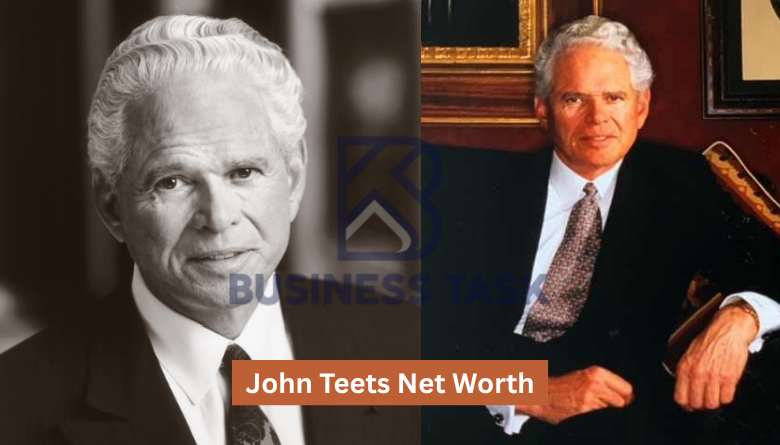john-teets-net-worth Revealed: How a Corporate Trailblazer Turned Bold Ideas into Long-Term Wealth

1. Setting the Stage
When business historians discuss American corporate reinvention, one name that inevitably surfaces is john-teets-net-worth. Synonymous with daring strategy and disciplined execution, john-teets-net-worth has become a magnet keyword for investors, leadership coaches, and curious Googlers alike. The fascination is understandable: Teets transformed sleepy brands into dynamic conglomerates, amassed a sizable personal fortune along the way, and left lessons that still resonate in 2025’s rapidly shifting economy.
2. Untangling the Two John Teets
Before diving into the dollars, it helps to clarify a frequent point of confusion. Search results reveal at least two high-profile figures named John Teets. One is the late John W. Teets (1929-2011), famed former CEO of Greyhound and Dial. The other is John Christopher Teets, a present-day board-member-cum-investor. Estimates for john-teets-net-worth therefore vary wildly: some outlets quote a peak between $50 million and $100 million for John W. Teets bsglife.com, while filings tracked by GuruFocus show roughly $106 k in stock for John Christopher Teets gurufocus.com. MarketScreener, meanwhile, lists $855 k based on a broader asset tally marketscreener.com. Context matters; this article focuses primarily on the elder industrial titan whose career produced the headline-grabbing numbers.

3. Humble Beginnings, Grand Ambitions
The story of john-teets-net-worth starts in the working-class neighborhoods of Illinois, where a young Teets juggled multiple jobs while studying marketing. Those early experiences sharpened his instinct for value—whether in underpriced real estate or overlooked P&L line items. Friends recall a habit of penciling mini balance sheets on napkins, long before spreadsheets existed. By the time he joined Greyhound Corp. in the 1960s, Teets had already internalized a timeless principle: wealth grows fastest when every small decision compounds in the same profitable direction.
4. Reimagining Greyhound: From Buses to Brand Portfolio
Greyhound in 1975 was best known for its iconic buses, yet margins were thin, and growth looked capped. Teets saw a different canvas. He spearheaded acquisitions in food service, consumer goods, and financial payments—laying the groundwork for what analysts later called a “horizontal Berkshire.” This aggressive diversification is central to understanding john-teets-net-worth. By turning a transportation company into a multi-sector powerhouse, he converted operational cash flow into equity appreciation, then recycled that appreciation into still more cash-generating assets.
5. Dial Corp. Spin-Offs and the Art of Unlocking Value
Perhaps the defining move in the saga of john-teets-net-worth came in the early 1990s, when Teets split Greyhound’s consumer products arm into Dial Corp. and reorganized service subsidiaries into Viad. The break-up crystallized hidden equity, attracting Wall Street coverage and bumping Dial’s stock price well above S&P benchmarks for five straight years. Net-worth calculators lit up, but so did philanthropic budgets: according to archived annual reports, Teets redirected millions into scholarship funds and community arts. His fortune was never just a private scoreboard; it functioned as a lever for public good.
6. Investment Philosophy: “Boring Cash Beats Flashy Paper”
Contrary to high-tech moguls of his era, Teets gravitated toward “boring” businesses—soap, airport catering, payment vouchers. In interviews he often quipped, “Clean hands, full pockets,” underscoring a belief that everyday necessities outclass flavor-of-the-month IPOs. That credo still frames modern searches for john-teets-net-worth; bloggers dissect his portfolio to illustrate how steady dividends and spin-off arbitrage can outrun headline cryptocurrencies over the long haul.
7. The Numbers Behind the Narrative
Exact figures fluctuate with the source, but analysts reconstructing john-teets-net-worth generally chart three mountain peaks. The first surge followed the 1983 sale of Armor meatpacking for roughly $2 billion, when Teets retained Dial’s consumer products and redeemed a hefty share package. The second spike coincided with Dial’s mid-1990s outperformance, adding tens of millions in capital gains. The final crest occurred during late-career board tenures, where director fees and option grants supplemented a portfolio already heavy with blue-chip dividends. Even after estate taxes, the family foundation reportedly managed assets north of $80 million—a testament to compounding disciplined over decades.
8. Philanthropy and Succession
Sizable fortunes invite equal measures of scrutiny and celebration, and john-teets-net-worth is no exception. Teets shielded much of his wealth from volatility by endowing charity vehicles focused on education, heart-health research, and small-town revitalization in the Midwest. He also pursued transparent succession planning, ensuring that stewardship of both assets and ideals passed smoothly to the next generation. Management scholars often cite his trust-centric governance as a model for entrepreneurs transitioning from operator to legacy builder.
9. Lessons for Today’s Wealth Builders
What actionable insights can an aspiring investor extract from john-teets-net-worth? First, embrace optionality: Teets welcomed businesses outside his initial skillset, provided cash flow was king. Second, stay patient with restructuring plays; the Dial-Viad split took nearly a decade from concept to market recognition. Third, diversify geographically and sector-wise without diluting expertise. Finally, remember the philanthropic dimension. The social capital Teets accrued paid reputational dividends that opened doors to favorable deal flow. In short, personal fortune and public impact need not be mutually exclusive.
10. Debunking Internet Myths
A quick Google session can send researchers down conflicting rabbit holes about john-teets-net-worth. One blog labels him a billionaire; another cites a six-figure brokerage statement. Such discrepancies stem from data attribution (which John Teets?), inflation adjustments, and whether one counts illiquid private holdings. A prudent reader triangulates credible filings, legacy media, and audited foundation reports rather than relying on click-bait headlines. Doing so underscores a broader truth: the real value of studying Teets lies less in an exact dollar figure and more in the repeatable frameworks he left behind.
11. The Continuing Relevance of a 20th-Century Playbook
Corporate landscapes mutate, yet the architecture of smart wealth endures. From Greyhound to modern logistics unicorns, the blueprint behind john-teets-net-worth—acquire strategically, spin off surgically, reinvest patiently—remains evergreen. Private-equity partners still cite his transaction sequencing in pitch decks; ESG advocates spotlight his early commitment to community reinvestment; MBA syllabi mine his case studies for timeless negotiation tactics.
12. Conclusion: Beyond the Balance Sheet
Ultimately, chasing a single headline number misses the point. john-teets-net-worth encapsulates the journey of a farm-boy-turned-chief-executive who saw potential where others saw stagnation, bet on it with unshakeable conviction, and then shared the winnings broadly. Whether valued at $50 million or north of $100 million, the story’s enduring worth resides in its blueprint for purposeful prosperity—a legacy more durable than any figure on a Forbes list.


